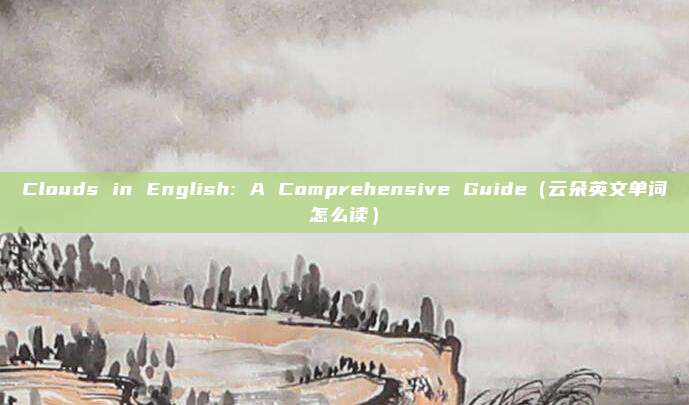Clouds in English: A Comprehensive Guide(云朵英文单词怎么读)
温馨提示:这篇文章已超过187天没有更新,请注意相关的内容是否还可用!
Introduction
Clouds are a fascinating and integral part of our daily lives, shaping our weather and climate. Whether we're trying to understand a simple weather forecast or exploring the science behind atmospheric phenomena, knowing how to describe clouds in English is essential. This article serves as a comprehensive guide to cloud terminology in English, including key terms, their meanings, and practical uses.
Clouds in English: Basic Terms
Cloud – The general term for a visible mass of water droplets or ice crystals suspended in the atmosphere at or near the earth's surface.

Cumulus Clouds – Also known as "heavenly wool" or "heap" clouds, cumulus clouds are fluffy and white, often seen on sunny days.
Stratus Clouds – These clouds form a low, gray layer, often covering the sky and giving a dull, overcast appearance.
Cirrus Clouds – Cirrus clouds are high, wispy clouds composed of ice crystals. They often signal the approach of fair weather.
Cumulonimbus Clouds – These towering clouds are associated with thunderstorms and can extend from the surface up to the tropopause.
Related Cloud Terms
Altocumulus – Altocumulus clouds are gray or blue-gray, with one part of the cloud darker than the other. They are typically seen at altitudes of 6,500 to 20,000 feet.
Nimbostratus – Nimbostratus clouds are dark, thick, and cover the entire sky, often producing continuous precipitation.
Cumulonimbus Towering Clouds – Cumulonimbus clouds have a flat base and can reach heights of up to 60,000 feet. They are responsible for severe weather like lightning, thunder, and heavy rain.
Clouds and Weather Patterns
Understanding cloud types is crucial for weather forecasting. For instance, according to the National Centers for Environmental Information (NCEI), cirrus clouds often indicate that a weather front is approaching, while nimbostratus clouds are a sign of rain or snow.
Practical Applications of Cloud Terminology
Knowing cloud terminology can be incredibly useful in various scenarios:
1、Weather Reporting: Describing cloud types accurately is essential for weather forecasters to provide reliable information to the public.
2、Agriculture: Farmers often monitor cloud types to predict weather patterns and plan their irrigation schedules accordingly.
3、Aviation: Pilots need to be aware of cloud types to avoid turbulence and plan flight paths safely.
Conclusion
Understanding cloud terminology in English is not only an intriguing aspect of meteorology but also a practical skill with various applications. Whether you're a meteorologist, a pilot, a farmer, or simply someone who enjoys observing the sky, being familiar with cloud types and their English names can enhance your appreciation of the natural world and aid in making informed decisions.
References:
- National Centers for Environmental Information (NCEI). (n.d.). Weather and Climate Data. Retrieved from [NCEI Website](https://www.ncei.noaa.gov/)
网站文章、图片来源于网络,以不营利的目的分享经验知识,版权归原作者所有。如有侵权请联系删除!





还没有评论,来说两句吧...